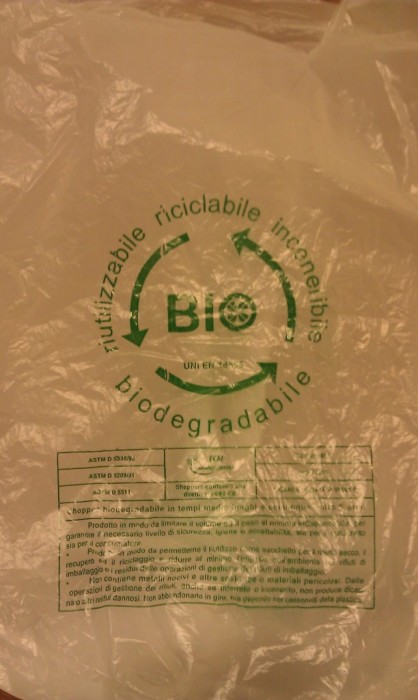
Biodegradable plastic bag
My in-laws recently visited Los Angeles and they came bearing gifts! During a trip to Italy, they went on a tour of Federica, a famous Murano glass production facility and maker of awesome Murano glass animals. They picked up a beautiful glass dolphin for me, which was very exciting to receive.
How is this relevant you ask? Well, that lovely glass dolphin was wrapped in bubble wrap and tied up in a plastic biodegradabile (Italian for biodegradable) bag. In big letters it says “riutilizzabile riciclabile inceneribile biodegradabile,” which according to Google translator means “reusable recyclable incinerable biodegradable.” (I have to admit, I’ve never thought of the benefits of using a plastic bag that I can set on fire, but I’m glad someone has.)
Then underneath the large text with the classic international symbol of three arrows for recycling, it says “shopper biodegradabile in tempi medio lunghi e comunque entro 5 anni.” According to Google translator, this means “shopper biodegradable medium-long time and in any case within 5 years.” I’m guessing that’s not an exact translation, but you get the gist…the plastic bag should degrade within five years.
At first I thought, “Why don’t we use biodegradable bags here? That seems so much better than a regular plastic bag.” Then after just a few searches about biodegradable plastic bags on the internet, I quickly became disillusioned. It turns out that a lot of energy is used during the process of producing biodegradable plastic bags. Also, many biodegradable plastic bags break down into toxins, but of course manufacturers don’t advertise those little details. As usual, there is much more to this issue than meets the eye and I’ve barely scratched the surface.
In the end, it’s probably best to shift away from all single-use plastic bags, biodegradable or otherwise, because it’s not a good use of resources. Why use hundreds of plastic bags in a lifetime when you could just use one canvas bag? It just doesn’t make sense. (Check back with me in five years to find out if this bag really degrades, I’m going to keep it around and see what happens.)
Leave a Reply